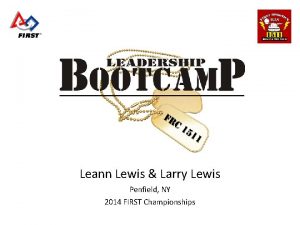Red Feather Solar Furnace Nathan Fisher Leann Hernandez

- Slides: 1

Red Feather Solar Furnace Nathan Fisher, Leann Hernandez, Trevor Scott Dr. Sarah Oman College of Engineering and Informatics, Northern Arizona University, Flagstaff, AZ 86011 Abstract Manufacturing & Testing Conclusion • The solar furnace was able to output 1684 Watts of heat which is better than the commercial options making it a success. • The final cost to create the prototype was $438. The commercial option costs between $700 -900. • For bulk pricing for 100 units for the prototype size of 3’ x 6’ would be $384 per unit. • Should they pursue the team's model as a replacement for the commercial models used, Red Feather would save $316 per unit. • A cost analysis was also conducted for a larger 4’x 8’ model which would cost $424 per unit based on bulk pricing. The NAU Capstone team is partnered with Red Feather to design a fully renewable solar furnace. Red Feather is a non-profit organization that helps the Native American people with their housing needs on the reservation. The Residents of the reservation in Northern Arizona previously received coal from a mine supplying the local power plant (Navajo Generating Station) which they burned to heat their homes, but both were shut down in November of 2019. In addition this, the inhalation of coal is known to cause respiratory illnesses. Thus the NAU Capstone team was tasked with designing a long term and sustainable solution to their heating needs. A solar furnace was chosen based off these requirements. Multiple customer needs and engineering requirements, developed with the customer, were considered in designing the solar furnace. The final design was developed from a decision matrix and refined using both engineering computations, as well as a comprehensive analysis of the failure modes of the device. System heat loss, fan optimization, and solar technology were researched to better understand what materials and what configuration would be best for the device. Only basic power tools will be needed to construct the solar furnace and Red Feather will be provided with a construction manual and video to help with replication of the device which will be distributed to those on the Native American Reservation. [1] Requirements The customer requirements include: • low cost • able to heat a home • durable • low weight • Easy to build. • Quiet System These translate into the primary engineering requirements: • Produce at least 1500 watts/day. • Less than $450 • Weight: <100 lbs. • Robust construction and materials • Fan noise between <40 d. B • Install time under 3 hours. The team successfully met all engineering requirements. The Quality Functional Diagram can be seen below: Table 1: House of Quality Figure 4. Solar Furnace Prototype References Results • The heat output test revealed the device generated a max of 1684. 95 watts of heat in ideal conditions. • This is enough heat energy to heat 500 - 800 square feet comfortably throughout a Flagstaff winter. • The similarly sized commercial model claims to output 1500 watts of heat, meaning the prototype is about 112% as effective of the commercial option, with only a slightly larger footprint. [1]“Red Feather Solar Furnace 2, ” orthern Arizona University, Jan-2020 [2] F. P. Incropera, T. L. Bergman, D. P. Dewitt, and A. S. Lavine, Incroperas Principles of Heat and Mass Transfer. John Wiley & Sons, 2017 [3]Heat Loss in PV Modules, ” PVEducation. [Online]. Available: https: //www. pveducation. org/pvcdrom/modulesand-arrays/heat-loss-in-pv-modules. [Accessed: 30 -Mar-2020]. [4]“Sizing Fans and Ducting for Solar Air Heating Collectors, ” Sizing Fand Ducting for Solar Air Heating Collectors. [Online]. Available: https: //www. builditsolar. com/Projects/Space. Heating/Fan. Sizing. htm. [Accessed: 28 -Mar-2020]. [5]“OD 1238 -12 HB-ORIN, ” Orion - Axial Fans | Galco Industrial Electronics. [Online]. Available: https: //www. galco. com/buy/Orion/OD 1238. [Accessed: 30 -Mar-2020]. [6] M. D. Egan, oncepts in thermal comfort. Englewood Cliffs, NJ: Prentice-Hall, 1975. [7]Thermal Conductivity of Metals, Metallic Elements and Alloys. Engineeringtoolbox. com, Acknowledgements. Figure 3. CAD Model of Solar Furnace Prototype. Red Feather L. L. C. NAU Mechanical Engineering Department Chuck Vallance Dr. David Trevas Dr. Sarah Oman

